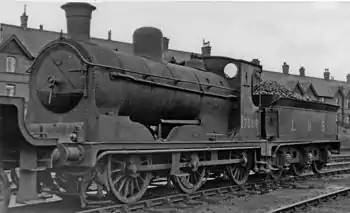Caledonian Railway 812 and 652 Classes
The Caledonian Railway 812 and 652 Classes were 0-6-0 steam tender locomotives designed by John F. McIntosh for the Caledonian Railway and introduced in 1899. They had the same boiler type as the 721 “Dunalastair” Class 4-4-0s. They were nicknamed "Jumbos" and they could reach speeds of up to 55 mph (89 km/h).[1]
| Caledonian Railway 812 and 652 Classes | |||||||||||||||||||||||||||||||
|---|---|---|---|---|---|---|---|---|---|---|---|---|---|---|---|---|---|---|---|---|---|---|---|---|---|---|---|---|---|---|---|
 Ex-CR 812 class No. 17596, not yet renumbered, at Corkerhill Locomotive Depot on 15 August 1948. | |||||||||||||||||||||||||||||||
| |||||||||||||||||||||||||||||||
| |||||||||||||||||||||||||||||||
| |||||||||||||||||||||||||||||||
| |||||||||||||||||||||||||||||||
Construction
96 locomotives were built, as follows:
| Year | Quantity | CR Nos. | Builder | Builders No. | LMS Nos. | BR Nos. | Notes |
|---|---|---|---|---|---|---|---|
| 1899 | 17 | 812–828 | CR, St. Rollox | Y054 | 17550–17566 | 57550–57566 | 828 preserved |
| 1899 | 10 | 829–838 | Neilson, Reid & Co. | 5613–5622 | 17567–17576 | 57567–57576 | |
| 1900 | 10 | 839–848 | Neilson, Reid & Co. | 5623–5632 | 17577–17586 | 57577–57586 | |
| 1900 | 15 | 849–863 | Sharp Stewart | 4633–4647 | 17587–17601 | 57587–57601 | |
| c.1900 | 15 | 864–878 | Dübs & Co. | 3880–3894 | 17602–17616 | 57602–57616 | |
| 1899 | 12 | 282–293 | CR, St. Rollox | Y058 | 17617–17628 | 57617–57628 |
| Year | Quantity | CR Nos. | Builder | Builders No. | LMS Nos. | BR Nos. | Notes |
|---|---|---|---|---|---|---|---|
| 1908 | 8 | 652–659 | CR, St. Rollox | Y087-Y086 | 17629–17636 | 57629–57636 | |
| 1908 | 4 | 662–665 | CR, St. Rollox | Y086 | 17637–17640 | 57637–57640 | |
| 1909 | 4 | 325–328 | CR, St. Rollox | Y086 | 17641–17644 | 57641–57644 | |
| 1909 | 1 | 661 | CR, St. Rollox | Y086 | 17645 | 57645 |
Seventeen were fitted with the Westinghouse air brakes for passenger train working, including the only surviving engine of the class, No. 828. All 96 passed to the London, Midland and Scottish Railway at the 1923 grouping. Only three, 17567, 17598 and 17610, had been withdrawn by the time of nationalisation in 1948. The last locomotive in service was not withdrawn until 1963.
Preservation
.jpg.webp)
Locomotive 828 (LMS 17566, BR 57566) is the sole survivor of the class and is an important example of Scottish industrial heritage. It is based at the Strathspey Railway. It was returned to regular service in 2010 and then again in March 2017 following heavy repairs. 828 is the final member of the first batch of engines built in 1899.
Belgian derivatives

Belgian State Railways (SNCB-NMBS) derived three series of steam locomotives (891 units) from the class 812 between 1899 and 1914. They had a shallower firebox, able to burn semi-bituminous coal and briquettes, allowing a shorter wheelbase due to its positioning above the rear axle. There were three classes
- Type 30 – first variant with several details in common with the Caledonian engines (cab windows, gauges and tender coupling). 82 built between 1899 and 1901.
- Type 32 (later renamed Type 44) – more powerful and fitted with a Belgian cab, higher steam pressure, new gauges and tender coupling. 502 built between 1901 and 1910
- Type 32S (later renamed Type 41) – same features but improved with a Schmidt superheater. 307 built between 1905 and 1914
Until 1909, they were the only new engines used with freight trains. They were also used on suburban and local passenger trains and some expresses on hilly sections. Most of them were retired between 1947 and 1959. Some of them were then used as stationary boilers and two of them (44.221 and 41.195) survive in museums. A third one (44.021), kept as a parts donor, was cut up for scrap in 2002.[2]
In fiction
In The Railway Series children's books, as well as its television adaptation Thomas the Tank Engine & Friends, by the Rev. W. Awdry, the characters Donald and Douglas ("the Scottish twins"), are based on the Caledonian 812 class. They carried fictional numbers (57646 and 57647) before coming to Sodor. This numbering places them as the youngest of the 652 class (see table above). [3]
References
- Train: The Definitive Visual History. DK Press. p. 98.
- "Archived copy". Archived from the original on 25 May 2018. Retrieved 25 May 2018.CS1 maint: archived copy as title (link)
- "Donald and Douglas". (The real prototype locomotives that inspired the Rev W Awdry). The Real Lives of Thomas the Tank Engine. Archived from the original on 31 October 2010. Retrieved 25 January 2011.
- Casserley, H. C. & Johnston, Stuart W. (1974) [1966]. Locomotives at the Grouping 3: London, Midland and Scottish Railway. Shepperton, Surrey: Ian Allan. pp. 178–179. ISBN 0-7110-0554-0.
External links
| Wikimedia Commons has media related to Caledonian Railway 812 class. |